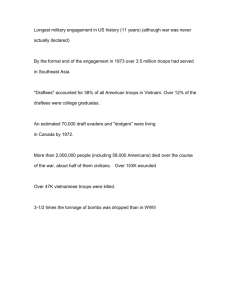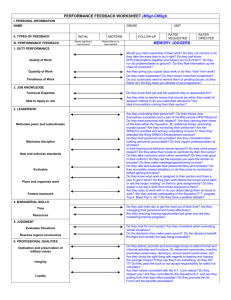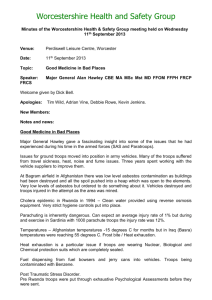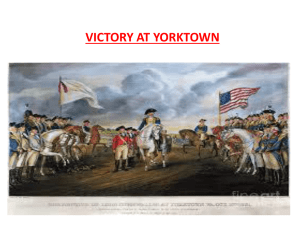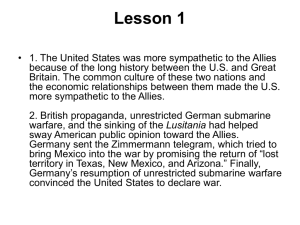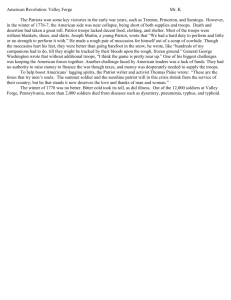sea power
advertisement
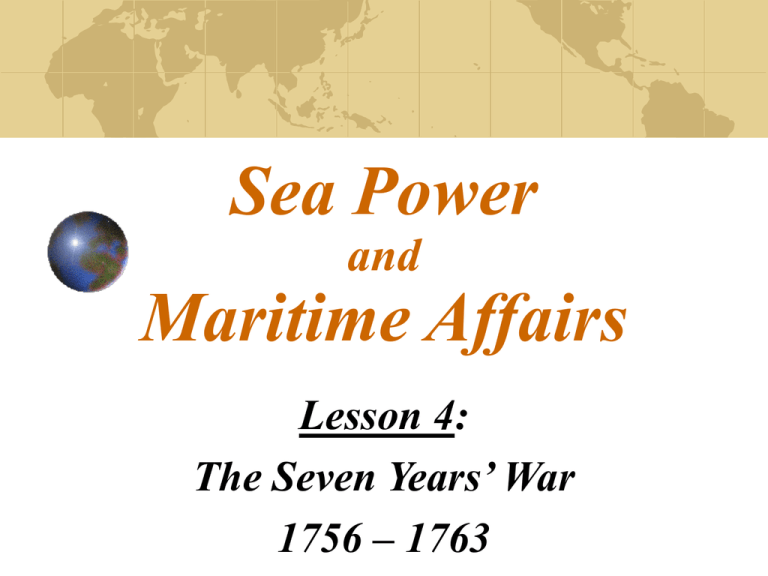
Sea Power and Maritime Affairs Lesson 4: The Seven Years’ War 1756 – 1763 Seven Years’ War (1756-1763) ☼ Geopolitical significance: ►First genuine world war ►Fought in German states, Mediterranean, America’s, Canada, West Indies, India, Africa, and Philippines ►Estimated 900,000 – 1.4 million people died ☼ Strategic significance: ►Classic example of conflict between land power (France) and sea power (England) “The Elephant” vs. “the Whale” ►England emerges as dominant colonial power in the world. France’s colonial position weakened Primary Causes ☼ Colonial struggle between British and French west of Appalachians ☼ Austria allies herself with France and Russia to recover Silesia ►Lost in War of Austrian Succession ☼ Frederick of Prussia turns to England to form Anglo-Prussian defensive alliance ☼ France aggressively open hostilities ►Retribution for losses suffered in 1713 ►Known as “French and Indian War” in America Battle of Minorca ☼ April 1756: 150 transports land 15,000 French troops, supported by 12 ships-of-the-line ►Troops outnumber British 5 to 1 ►British retreat to Fort St. Philip ☼ British send ADM John Byng to raise the siege ►13 ships-of-the-line ►Regiment of fusileers ►Use “all possible means in his power” to lift siege off Minorca on May 19th sights the French ☼ Dying wind prevents engagement till the 20th ☼ Byng Battle of Minorca (20 May 1756) ☼ Byng’s signals confused and he over cautiously follows formal instructions ►French inflict heavy damage Prevent troops from being landed ►British garrison surrenders a month later ☼ Byng shifts his fleet to Gibraltar ☼ Byng court-martialed ►Found guilty of failing “to do his utmost” ►Executed 14 Mar 1757 ►Brings into question inflexible rules of the Permanent Fighting Instructions Permanent Fighting Instructions Van Center Rear Rear Center Van Wind Pitt’s Plan ☼ Cabinet reshuffled after loss of Minorca ☼ William Pitt the Elder – Minister of War ☼ “Hitting” ►Draw off French troops by coastal raids ►Attack overseas colonies of France and Spain ►Increase British empire, trade, wealth, and war chest ☼ “Holding” ►Blockade French ports and seek destruction of battle fleet ►Support continental allies with subsidy and token forces to keep French occupied French Counter Strategy ☼ Raid British maritime commerce ☼ Defend French Colonies ☼ Unite Atlantic ☼ Invade and Mediterranean fleets England herself The British preponderance at sea made most of these futile efforts “Conjunct Expeditions” ☼ Amphibious raids against French ports ►Force French to retain troops for coastal defense ►Examples of “military assistance” for Prussians ☼ Rochefort (1757) ►Poorly planned, but Wolfe learns valuable lessons used at Quebec ☼ St. Malo (June 1758) ►13,000 troops land ►Spend a week ashore, burn more than 100 privateers ☼ Cherbourg ►Take (August 1759) temporary possession and destroy fortifications Fleet Actions ☼ Lagos Bay (1759) ►Toulon fleet escapes through Strait of Gibraltar to link up with Brest fleet to cover invasion of England ►British pursue and overwhelm French using general chase tactics ☼ Quiberon Bay (1759) ►Brest fleet takes advantage of British absence due to a storm and sails when wind moderates ►British intercept and using general chase tactics drive French into dangerous, reef strewn bay ☼ Effective blockade and naval victories free bulk of Royal Navy for employment overseas American Campaign ☼ N. America paramount objective in Pitt’s strategy ☼ Ultimate objective = Quebec ►Royal Navy sweeps French Stops supplies and reinforcements ►Louisburg shipping from the Atlantic taken as base to blockade St Lawrence (1758) ►1759 British launch three-pronged offensive Amherst with 12,000 men (mostly colonists) using Richelieu River-Lake Champlain route – Required capture of Fort Ticonderoga and Crown Point Smaller force to capture Fort Niagara and converge on Quebec from the west Strong amphibious force ascends St Lawrence from the sea Fall of Quebec ☼ British fleet anchors just out of cannon shot of Quebec and disembarks Wolfe’s troops on the Isle of Orleans ☼ French leave walled city and set up camp on northern bank of the river ► Block mouth of St Charles River with sunken hulls ► de Bougainville guards shore upstream ☼ Navy makes a feint while Wolfe plans landing ► Strong force in flat-bottom boats moves with the tide up river, followed by de Bougainville ► When tide turns the boats reverse course, tired French soldiers can’t keep up and the British land at Anse du Foulon ☼ Gen Montcalm marches out to meet the British and is defeated before de Bougainville can come to help ► Canada falls to the British Campaign in India ☼ French and British East India companies secure aid from royal forces in their struggle for India ☼ Three major engagements fought between evenly matched fleets were tactical draws ►Indecisiveness ☼ French of Formal Tactics lose their base at Chandernagore ►Nearest refitting station is Mauritius (2,000 miles) ☼ Ability to refit and resupply allows the British to win a battle of attrition ►Importance ☼ India of Communications stays in British hands until after WW II Operations in the West Indies ☼ West Indies supply majority of tropical products ►Sugar planters make a fortune ►Important in the slave trade ☼ Islands used as bases for privateers that raised havoc on British commerce ☼ British take the opportunity to expand their Empire as well as shut down the privateers ►Guadeloupe, Dominica, Martinique, Grenada, St, Lucia, and St. Vincent taken from the French Fall of Havana (1762) ☼ Spain enters the war in 1762 ☼ British immediately plan operation against Havana with 15,000 troops supported by 50 men-of-war ►ADM Pocok uses little-used Old Bahamas Channel ►Spanish sink three ships of the line (out of 12) across the mouth of the channel to prevent entrance Also locks fleet in enabling British to not worry about a sortie ►British land troops east of the city, lay siege to El Morro Complete a tunnel and explode a mine allowing troops to storm the fortress ►Havana (and thus Cuba) falls to the British Other Operations ☼ British sea power gave them the ability to attack where AND when they wanted ☼ Also allowed small ventures to: ►Increase economic power ►Improve bargaining position at the peace table ☼ Examples: ►French slave-trading stations (1758) ►Belle-Ilê (1760) ►Manila (1762) Taken after two week siege and bombardment by East India Trading Company troops supported by an 8 ship squadron Treaty of Paris (10 Feb 1763) ☼ British obtains: ►Canada ►Florida from Spain (for returning Cuba) ►Senegal and Minorca returned ►Much of India ☼ France renounces claims between Appalachians and the Mississippi ☼ Spain gets Cuba and Philippines back, as well as New Orleans and the Louisiana Territory ☼ British give back Martinique, Guadeloupe, Belle Ilê, St Lucia and other minor French possessions Next Time: Questions? Chapter 4 – The American Revolution
